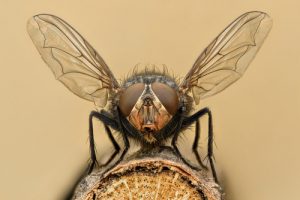Tracking Down Indoor Gnats
By Chris Williams on April 11, 2011.
Q. We’ve noticed gnats inside in a couple areas of the house. We’ve killed quite a few but it seems like there’s always more. Any idea what they are and why they’re in the house?
A. The first question to answer is are the gnats really coming from inside the house or are they getting in from outside. Their numbers will usually answer that question. If you’re seeing just a few occasionally, they may be coming in from outside through torn screens or doors left open. But if you’re killing gnats every day, there is probably an inside source.
There are several small flies, (or “gnats” if you prefer), that can actually breed inside your home. As a group, you could call them “wet gunk gnats” since the larvae of all of these tiny flies feed on some type of organic goo. Telling exactly what type of fly you’re dealing with might require an expert identification. You can get some clues based on where you see the gnats.
 (1) Fruit fly – This is probably the most common gnat inside homes. It’s light brown, usually with reddish eyes. The larvae feed on overripe fruit or vegetables. Adult flies hover in small circles and are attracted to yeasty or fermenting odors. You may find fruit flies hovering around your wine glass, ripe fruit on the counter, or garbage cans. (See more in our website Pest Library under Flies)
(1) Fruit fly – This is probably the most common gnat inside homes. It’s light brown, usually with reddish eyes. The larvae feed on overripe fruit or vegetables. Adult flies hover in small circles and are attracted to yeasty or fermenting odors. You may find fruit flies hovering around your wine glass, ripe fruit on the counter, or garbage cans. (See more in our website Pest Library under Flies)(2) Fungus gnat – This little fly looks somewhat like a miniature mosquito. It’s dark with long legs and long antennae and tends to run across surfaces in a jerky manner rather than flying. The larvae live in soil and feed on decaying vegetation and are most often associated with overwatered house plants. You’ll likely find the flies hovering around your house plants or on the soil surface.
(3) Drain fly – This tiny gnat is sometimes called a moth fly since it has fuzzy wings. The larvae are usually found in drains where they feed on the scummy material that grows on the inside of drain pipes (see Drain Fly Blog 3/03/2011). Adult flies may be found hovering around bathroom sink or tub drains, or other household drains. These flies fly in short hops but are often found resting on bathroom walls.

(4) Phorid fly – Phorid flies are brownish and appear humpbacked when viewed in profile. Phorid fly larvae feed on many disgusting things, including dead animals, feces, and slimy drains. In homes, they are often associated with sewer breaks or plumbing leaks under the slab. Adult flies prefer to run on surfaces in a quick, jerky manner and are attracted to lights.
Some of these flies are easy to control. Fungus gnats, for instance, can usually be eliminated by cutting back on watering house plants. But control of others like the phorid fly can be much more involved and may require a plumber. Call Colonial first. We can determine which of the wet gunk gnats are causing your problem, can find the source of the problem, and can outline a treatment program